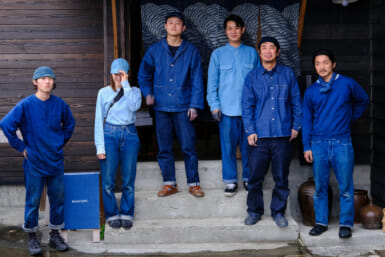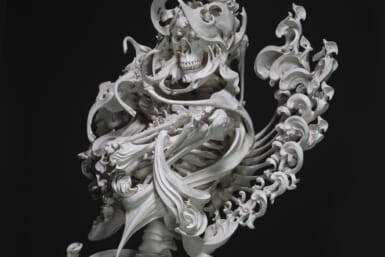Probably the most irritating of clichés for me is the way in which just about any discussion of contemporary Japanese art gets hijacked by people wanting to bring up Takashi Murakami or pretty much any artist bringing aspects of manga and anime in their work. It’s not that I particularly hate this particular flavour of pop art (although I’ve got little time for Murakami); it’s just that there are a lot of people out there desperate to think of Japan as that place where everything is always about anime. And Murakami and Yoshitomo Nara are the inevitable tiresome tag-alongs to that line of reasoning. For every moment that I spend trying to illustrate the breadth and depth of contemporary Japanese art, there are a thousand other voices out there crying out for more manga.
So it was quite by accident that I entered Akira Ishiguro’s show “ISHIGURO-YA.” Nichido Contemporary Art is one of those galleries that I will drop in on if I happen to be in the area. And on this occasion, the artist happened to be there, and chatted with me about his work…which, yes, is heavily manga influenced.
For the first few moments when you look at Ishiguro’s work, it seems like pure parody. He fills his canvas with a carefully rendered classical scene — the fat Botticelli-like cherubim and seraphim that we’re familiar with — and then substitutes the main figure with a slender anime character or a pop culture icon like the Kewpie Mayonnaise baby. Furthermore, in this show, he turned the entire room into an installation by covering the walls in red wallpaper that he had designed himself, and building a pillar in the middle of the gallery where there had been no pillar before. I recognized it as a kind of salon room, but when Ishiguro began chatting with me about his concepts, he quickly pulled up a photo of the inside of the National Gallery of London. It was a dead ringer.
Flipping through various images on an iPad, Ishiguro went from a shot of the Parthenon to the White House, from there to the grill of a Rolls Royce. He was eager to point out the string of unexpected things that run back to ancient forms which, for whatever reasons, have been declared beautiful and acceptable forms of beauty. We do not re-invent concepts, we simply alter them and they evolve along with us.
Therefore, Ishiguro’s artificial pillar in the room gives the room a false sense of history just as the ornate gold frames around paintings and the red walls do. The mimicry makes us sense that it is somehow false and in bad faith, yet the “real” pillars of the National Gallery, the “real” gold frames around its paintings are derivative of older forms themselves, and this is a part of what Ishiguro seems to be driving at.

There’s little new in the contrasting of “high art” with “low art” these days. But there’s more than just that going on in Ishiguro’s work, and perhaps whether he intends it or not. Here, you are not merely asked to consider the two on the same level, but to accept the imposition of pop images into what appears to be classical work. Ishiguro’s paintings are painstakingly authentic in technique. The work that went into each is more than anyone would be willing to do for the sake of parody. And there is a kind of tension in accepting the fact that these anime figures exist on the same canvas — even more so in the fact that they came from the same brush and the same hand.
The manga-esqe characters seem to physically interacting with the other inhabitants of the painting at times. You are forced to compare faces and bodies, to see the abstractions, the stylizations; inspect how they make the eerie transition from flat cartoon to rounded figure. Yet both the manga and classical figures are reproductions. Does the classical painting style have more value because it is more time consuming to produce? Or less, because it is derivative and outdated?
The question I regret not asking Ishiguro is why he chose to juxtapose Western painting and Japanese anime. While you will often hear the tale that Japanese anime and manga artists were working toward emulating Disney cartoons, a look at zen works by painters like Fugai, or even the tradition of ukiyo-e, reveals a rich history of art in which line-drawing and flat colour have long been accepted. While Japanese painters have taken a lot from the yōga tradition (painting in the Western style) it has always seemed to me that anime owes its form equally, or more, to Japan’s own history. Add to that questions of changes in the perception of beauty and women’s bodies — since that is what is most frequently, and somewhat disturbingly, replaced in these images — and there’s a lot to consider here.
Sadly, the show is now over. But it will be interesting to see where Ishiguro takes this in the future. He’s a character worth keeping an eye on.









